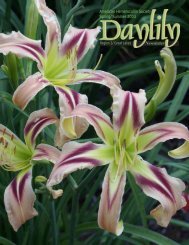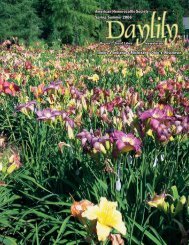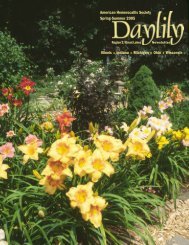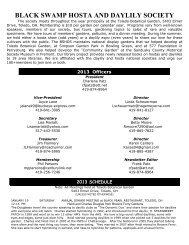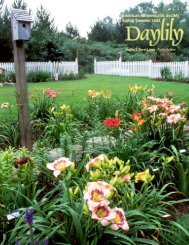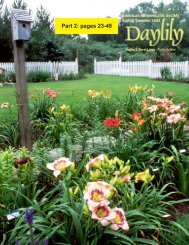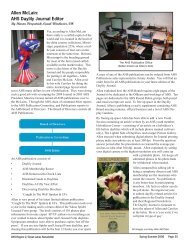Pages - AHS Region 2
Pages - AHS Region 2
Pages - AHS Region 2
Create successful ePaper yourself
Turn your PDF publications into a flip-book with our unique Google optimized e-Paper software.
loom pink in June when I cut them back for new foliage growth as<br />
a foil for daylilies in July. Autumn color is a spectacular flame blend.<br />
I always have a few of these to mix with daylilies in the coral,<br />
apricot and gold range, a simply spectacular combination. For a<br />
gentler color approach, try S. ‘Golden Princess’ or other cultivars<br />
with softer yellow foliage and paler pink flowers.<br />
Spirea ‘Shoribana’ or ‘Shibori’ (spelling found both ways) has<br />
lovely green foliage but blooms in a blend of pink, white, and rose<br />
flowers from May to October if deadheaded. It stays under 3' for me<br />
and is a great plant to place with pink and white daylilies. It also<br />
looks great with white daylilies with rose or purple eyes, such as<br />
Hemerocallis ‘Pandora’s Box’ (Talbott 1982).<br />
A new spirea on the market is ‘Mellow Yellow’ – its willowy<br />
leaves are a pale yellow in color and arch gracefully all season,<br />
with delicate white spring flowers. The foliage keeps its color all<br />
season, even in partial shade. I’ve planted Hemerocallis ‘Etched<br />
Spirea ‘Mellow<br />
Yellow’ with<br />
Hemerocallis<br />
‘Diabolique’ and<br />
‘Etched Eyes’.<br />
Eyes’ (Kaskel 1994) and H. ‘Brookwood Black Kitten’ (Leo Sharp<br />
1995) in front of it for a bright color contrast.<br />
Weigelas are a great old fashioned plant available in a wide variety<br />
of foliage colors, but most are large enough to qualify as background<br />
shrubs. The exception is a new dwarf version of ‘Wine and Roses’<br />
called ‘Midnight Wine’. It stays around 2' and has lush wine colored<br />
foliage with deep rose flowers in May and some rebloom in August<br />
through September.<br />
Euonymous fortuneii, not the flaming shrubs of fall, but the small<br />
evergreen types that creep and crawl around the garden are an<br />
extremely useful clan, but prone to spider mites if grown in too dry<br />
or hot conditions. They will take partial shade, making them well<br />
suited for growing under small trees and at the edge of shaded<br />
beds. They keep their foliage year round, making them as useful as<br />
a foil for daffodils in spring as they are for daylilies in summer. They<br />
Above:<br />
A nice compliment of<br />
Lynn’s glistening,<br />
bright blue, ceramic bird<br />
bath in her spring<br />
garden with Spirea<br />
‘Goldflame’ .<br />
Right:<br />
Spirea ‘Magic Carpet’<br />
with Coleus and<br />
Hemerocallis ‘Two to<br />
Tango’ and H. ‘Peach<br />
Fairy’.<br />
root where they touch the ground but are not invasive in my clay<br />
soil; I just cut off the rooted pieces and plant them elsewhere.<br />
Favorites include Euonymous ‘Emerald Gaiety’, a variegated green<br />
and white, E. ‘Emerald and Gold’, a variegated green and gold,<br />
‘Blondy’ and ‘Moonshadow’, both of which have a much higher<br />
percentage of gold in the variegation, and ‘Harlequin’, which stays<br />
very low and has a very sophisticated grayish green and white<br />
variegation on a very small leaf. I particularly liked E. ‘Harlequin’<br />
Left: Hemerocallis<br />
‘Velvet Shadows’<br />
contrasted against the<br />
silvery foliage of<br />
dwarf evergreen<br />
Chamaecyparis<br />
pisiferea ‘Snow’.<br />
Right: Hemerocallis<br />
‘Ribbon Candy’ rising<br />
up between<br />
Euonymous ‘Emerald<br />
and Gold’.<br />
Page 40 Fall 2005 - Winter 2006 <strong>AHS</strong> <strong>Region</strong> 2/Great Lakes Newsletter



